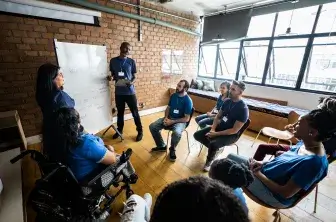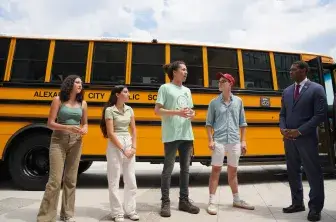Strategy 1: Prioritize Equity, Fairness, and Justice
Invest in Vulnerable Communities

Action on climate change will cause many disruptions at the community level. Investments must shift to supporting new clean industries, and the country will need new infrastructure projects to manage climate impacts. Federal policies must protect communities that are already overburdened by pollution and under-investment. Instead, investments must focus on these vulnerable communities by training workers and improving social cohesion.
Promote funding for project codevelopment through public-private partnerships and federal incentives.
More recommendations
Addressing climate change requires profound changes to American society. America must prioritize investment in both communities on the front lines, who will bear the brunt of climate change impacts, and communities that will be most severely affected by the transition to alternative energy sources and climate adaptation efforts. Without specific and targeted measures, historically marginalized communities will continue to experience disinvestment, neglect, and injustice.
Increasing investments to help these communities is an immediate priority. While some communities may find it easier to transition to wind, solar, geothermal, or nuclear energy compared with others, investing in all communities is crucial to foster diverse and resilient economies that are not solely reliant on the energy sector.[i] These investments should encompass increased research funding as well as support for local businesses and community resources, including essential services like health care and housing.
Workforce development and job retraining programs can help realize a more just transition by creating opportunities for workers, their families, and all those displaced by climate impacts and the energy transition. In New Mexico, the government, utilities, the Navajo Nation, and environmental organizations collaborated to develop the Energy Transition Act, which has allocated $40 million to community and workforce development. In addition, the Public Service Company of New Mexico partnered with the Navajo Nation to provide scholarships to Navajo students for job training in advance of coal plant closures.[ii]
In addition to economic development, communities will require infrastructure investment to respond to climate change. This requires significant financial resources, which are not equally available to all communities. Investments from agencies such as the Appalachian Regional Commission can provide improvements in infrastructure and educational institutions.[iii] Whenever possible, communities should have ownership in these projects, such as the 235-megawatt wind farm majority-owned by the Standing Rock Sioux Tribe in North Dakota. Investment in local adaptation is essential to communities already at the greatest risk of climate hazard or those located near existing sources of pollution. Retrofitting homes in low-income areas, such as through the Weatherization Assistance Program, creates green solutions that lower energy bills and decrease health risks from extreme heat.[iv]
Planning new projects should include a comprehensive analysis of benefits and liabilities that incorporate the full range of potential impacts, including on local environment, economy, health, and social cohesion. Evaluating these benefits should include engaging in discussions with communities to understand local concerns, ideas, and interests while being mindful of potential power imbalances. Not all benefits or impacts are easily quantified; in these cases, additional measures must ensure that benefits are weighed appropriately. There are several examples of this approach to draw from, including a 2021 Army Corps of Engineers assessment that weighs social, environmental, and economic benefits and a 2023 research study of climate interventions that incorporates health.[v]
Promote funding for project codevelopment through public-private partnerships and federal incentives.
Frontline communities benefit when projects emerge through codevelopment, wherein community members and researchers or project developers participate as equals. Establishing more federal funding incentives for codeveloping projects with frontline communities encourages businesses to create projects that actively seek input from communities throughout the project lifespan, decrease concerns over costs, and make funding applications more competitive to public and private funders.
Private sector and philanthropic contributions can make codevelopment more feasible by providing technical expertise, job retraining, and resources for community resilience. These partnerships remain crucial for equitable support of communities disrupted by climate impacts, green energy transformations, or adaptation.
One such example is the Partnership for Resilience and Preparedness (PREP), which is a public-private partnership between the World Resources Institute, the National Oceanic and Atmospheric Administration, and the insurance company Swiss Re.[vi] Through its funding and technical support, PREP has helped build capacity for climate adaptation planning in several communities, including the Biloxi-Chitimacha-Choctaw tribe in Louisiana, which is one of the first communities in the United States to be affected by climate-induced migration.[vii] The tribe is located on Isle de Jean Charles, a small island in the Gulf of Mexico that has lost over 98 percent of its land due to rising sea levels, coastal erosion, and subsidence.[viii] PREP helped the tribe develop an adaptation plan, build sustainable and elevated housing for residents, create job opportunities for those displaced, and preserve the tribe’s cultural heritage and identity.
Government incentives also encourage codevelopment. The Inflation Reduction Act (IRA) of 2022 provides tax credits for projects in areas experiencing recent unemployment from a fossil fuel industry closure or transition. Other government incentives, such as the Department of Housing and Urban Development’s Community Development Block Grant (CDBG) program, incentivize investments in infrastructure improvements that make business operations possible, such as incubators for green technology. In Baltimore, CDBG funds supported the creation of an incubator focused on sustainable manufacturing in collaboration with local communities. Housed at the University of Baltimore, this incubator has supported the development of several successful businesses that produce energy-efficient LEDs and manufacture lightweight materials for green infrastructure while also promoting economic growth in traditionally underserved neighborhoods.[ix]
[i] Adie Tomer, Joseph W. Kane, and Caroline George, “How Renewable Energy Jobs Can Uplift Fossil Fuel Communities and Remake Climate Politics,” Brookings Institution, February 23, 2021, https://www.brookings.edu/research/how-renewable-energy-jobs-can-uplift-fossil-fuel-communities-and-remake-climate-politics/.
[ii] Office of the Governor Michelle Lujan Grisham, “Governor Signs Landmark Energy Transition, Establishing New Mexico as a National Leader in Renewable Transition Efforts,” press release, March 22, 2019, https://www.governor.state.nm.us/2019/03/22/governor-signs-landmark-energy-legislation-establishing-new-mexico-as-a-national-leader-in-renewable-transition-efforts/. Commission cochair Patricia Vincent Collawn has been central to these activities, as has Commission member Hilary Tompkins. Jonathan P. Thompson for the Energy News Network, “New Mexico’s Coal Transition Law Still Faces an Uncertain Timeline,” New Mexico In Depth, September 2, 2022, https://nmindepth.com/2022/new-mexicos-coal-transition-law-still-faces-an-uncertain-timeline/.
[iii] Appalachian Regional Commission, “Investing in Appalachia’s Economic Future,” https://www.arc.gov/ (accessed June 12, 2023); and Linda Lobao, Mark Partridge, Oudom Hean, Paige Kelly, Seung-hun Chung, and Elizabeth N. Ruppert Bulmer, Socioeconomic Transition in the Appalachia Coal Region: Some Factors of Success (Washington, D.C. : World Bank Group, 2021), http://documents.worldbank.org/curated/en/531201635134585522/Socioeconomic-Transition-in-the-Appalachia-Coal-Region-Some-Factors-of-Success.
[iv] See U.S. Department of Energy, Office of State and Community Energy Programs, “Weatherization Assistance Program,” https://www.energy.gov/scep/wap/weatherization-assistance-program (accessed June 21, 2023).
[v] R. D. James, Department of the Army, Office of the Assistant Secretary, “Memorandum for Commanding General, U.S. Army Corps of Engineers, Subject: Policy Directive—Comprehensive Documentation of Benefits in Decision Document,” January 5, 2021, https://www.nationalwatersupply.org/post/usace-policy-directive-on-comprehensive-consideration-of-total-project-benefits; and Courtney Howard, Andrea J. MacNeill, Fintan Hughes, et al., “Learning to Treat the Climate Emergency Together: Social Tipping Interventions by the Health Community,” The Lancet Planetary Health 7 (3) (2023): e251–e264, https://doi.org/10.1016/S2542-5196(23)00022-0.
[vi] See Partnership for Resilience and Preparedness, “Visualizing Data to Build Climate Resilience,” https://prepdata.org/ (accessed June 12, 2023).
[vii] Isle de Jean Charles Biloxi-Chitimacha-Choctaw Tribe and National Academy of Sciences, Preserving Our Place—A Community Field Guide to Engagement, Resilience, and Resettlement: Community Regeneration in the Face of Environmental and Developmental Pressures (Isle de Jean Charles: Isle de Jean Charles Biloxi-Chitimacha-Choctaw Tribe, 2019), https://static1.squarespace.com/static/5672cfb1d82d5e366e753691/t/5dfc077ef8a68c27967cc40c/1576798088266/FINAL+FIELD+GUIDE+reduced.pdf.
[viii] Madaline King, “A Tribe Faces Rising Tides: The Resettlement of Isle de Jean Charles,” LSU Journal of Energy Law and Resources 6 (1) (2018): 13.
[ix] AccelerateBaltimore 2022, “About the Program,” https://www.acceleratebaltimore.com/.







